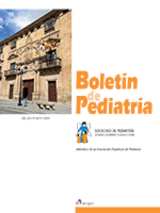Estudio descriptivo de 623 niños atendidos por un pediatra en un centro de vacunación internacional
M.B. Robles García
Bol. Pediatr. 2014; 54 (227): 29 - 35
Introducción. Los viajes internacionales en niños continúan ascendiendo, sin embargo, la información de la que se dispone de este grupo de viajeros en España es escasa. Los padres y niños deben recibir consejos generales y específicos del tipo de destino, viajero y, en su caso, vacunales y de quimioprofilaxis de malaria. La especialización recomendaciones de esta consulta impulsa a la unión de actividades. Metodología. Descripción de variables demográficas, vacunaciones administradas y quimioprofi laxis de malaria en 623 niños que acuden a un Centro de Vacunación Internacional entre los años 2008 y 2012 y que realizan consulta con la pediatra del centro. Resultados. Un total de 623 (4,03% de los viajeros que consultaron) cumplieron criterios de inclusión. La mediana de edad fue de 3,66 años (desviación intercuartílica: 3,31) y la media 4,91 (DS: 1,59). Un 72,07% viajaron para visitar amigos y familiares y un 68,06% a América Central y del Sur. La vacuna de la fi ebre amarilla, meningitis tetravalente de polisacáridos, tifus y hepatitis A se administró a 28,07%, 38,70% y 83,30% de los viajeros, respectivamente. Ningún niño fue vacunado de rabia. Un 19,26% recibieron quimioprofilaxis de malaria. Conclusiones. Relacionando los resultados con la población general atendida en los centros de vacunación internacional, los niños estudiados recibieron menos vacunas y quimioprofi laxis. La atención especializada de la consulta es fundamental para valorar el riesgo-beneficio de cada actuación.
Descriptive study of 623 children in consultation with a Pediatrician of an International Health Clinic
Introduction. International travel in children is continuing to rise, however, in Spain little is known about this group. Parents and children should be given general and specific advice on their travel destination, and if needed, vaccination recommendations and malaria chemoprophylaxis. The focus of the consultation is to unite preventive and curative practices.
Methodogy. A descriptive study using demographic variables, vaccinations administered and malaria chemoprophylaxis, in 623 children who attended the International Health Clinic between the years 2008 and 2012 in consultation with the children's clinical specialist.
Results. A total of 623 children (4.03% of the travelers seen) met the inclusion criteria. The median age was 3.66 years (interquartile deviation: 3.31) and the mean age was 4.91 years (SD:1.59). A total of 72.07% traveled to visit relatives and friends, and a total of 68.06% traveled to Central and South America. Vaccinations for yellow fever, meningitis tetravalent polysaccharide, typhoid and hepatitis A were administered to 28.07%, 38.70%, and 83.30% of travelers, respectively. No child was vaccinated for rabies. A total of 19.26% received malaria chemoprophylaxis.
Conclusions. The children seen received less vaccinations and chemoprophylaxis than the average travelers at the health clinics. Specialty pediatric care is essential to assess the risk-benefit of each intervention.
Artículo completo (PDF) (303 kb.)
- Otros
